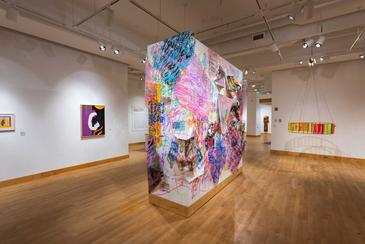
Contemporary art mingles with vintage party dresses at Towson University’s ‘All Night Party’
By Susan Isaacs and Erin Lehman
January 12, 2021
Click here to view the full article.
Co-curators J. Susan Isaacs and Erin Lehman write an essay about their exhibition "All Night Party," which places contemporary works in conversation with 20th century party dresses, drawing similarities between America's political climate then and now. "All Night Party" is (virtually) on view through June 30, 2021 via Towson University's website.
“People are trapped in history and history is trapped in them.” — James Baldwin from “Stranger in the Village.” 1953.
All Night Party began with the idea of celebration and gathering conceived by Erin Lehman after Professor of Costume Design in the Department of Theatre Arts, Julie Potter, lamented that there were so many fabulous party dresses from the 1920s in the Towson Historical Clothing Collection that were never seen by the public. Ultimately, we chose 10 garments from the 1920s—1980s to begin the core of an exhibition. We grew the exhibition to include relevant paintings, collages, sculpture, and installation by six artists: Dennis Beach (DE), Bobby Coleman (MD), Alex Ebstein (MD), Tim McFarlane (PA), Dominie Nash (Washington D.C.), and McKinley Wallace III (MD). A companion exhibition in our smaller gallery, “All Decked Out,” focusing on adornment, was co-curated by Susan Isaacs and Jewelry and Metalsmithing Lecturer/Coordinator, Luci Jockel and included the work of 21 artists from the US and abroad. We installed the exhibitions, but they could only be viewed in person by TU students, faculty, and staff. Consequently, we developed a rich online presence that would remain on view for a much longer period; it includes lectures, tours, interviews, studio visits, a podcast, and an original musical composition.
We chose artists for “All Night Party” whose works we felt resonated in some way with the past but were very much of the present, signaling Dada, early 20th-century modernism, Abstract Expressionism, Pop and Op Art, Minimalism, the Studio Craft Movement, graffiti, 80s street art, and installations, or revealed connections to protest murals and posters. We believed that the events of 2020 could be addressed through the dual lenses of art and history, even if the artists themselves did not always envision that context when making the work. Perhaps that is because we are both art historians who not only appreciate formal elements but who also yearn to establish historical and conceptual context for our exhibitions.
We wrote in our curatorial statement that:
We see the visual arts as a connecting thread between the significant historical events of the 20th century . . . and the daily experience of the people who lived through these eras, and between these events and those of the present moment, including national pandemics that upend daily life in the form of flu or Covid, and the Civil Rights and the Black Power Movements whose actions, lessons, aesthetics, and messages inform and echo Black Lives Matter. From McCarthyism to the ultra-patriotism of 9/11, Jim Crow to mass incarceration, history continues to find innovative ways of repeating itself, reminding us both how far we have come, and how much we have left to accomplish.
To us, there is a relationship between the historical garments and the works in the show that creates a liminal experience, welcoming the viewer to find a personal connection between the clothing, the art of daily life, and the art in the gallery. The artists were all supportive of this approach. While we began organizing the exhibition two years in advance, by the time we installed it, the theme held poignant memories of a time when we could gather for parties, so we instead “gathered” work in the gallery to celebrate the vision of each artist.
Dennis Beach (Schmidt Dean Gallery) creates sculptures and paintings that are carefully crafted with intense colors. He cuts and molds wood and sometimes employs plastic in his sculptures, resulting in dynamic forms that explode with color while demonstrating minimalist exactitude. He knowingly engages with the vocabulary of Modernism, including Pop, Op, and Minimalism. The results are sincere objects of beauty that demonstrate a meticulous hand but which also playfully nod to post WWII art styles. A tour of his studio, available on the exhibition website, offers a behind-the-scenes glimpse of his practice.
.......
An artist well known to Philadelphia audiences, Tim McFarlane (Bridgette Mayer Gallery), created an installation specifically for “All Night Party.” He also provided a two-part illustrated lecture which is available on the website. McFarlane is an observant chronicler of the contemporary environment, presenting multilayered images and materials that suggest graffiti and other debris from his surroundings; he lives in the city, and the impact of the construction sites, painted, layered, and pealing paint of old buildings that he walks by every day is revealed in this installation. Memory plays a role in his practice, where he brings together past and present and private and public space. He utilizes chance and improvisation to invent and reinvent unique installations, drawings, and paintings. Gestural marks and brushstrokes overlap and engage with the space.
